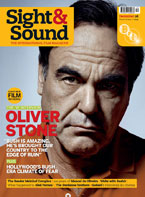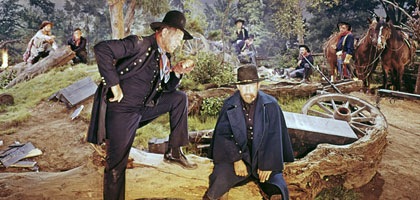
NOZONE: The wide, wide West
DVD Review: How the West Was Won

It packed movie theatres in the 1950s and now it's back: Tim Lucas on the panoramic Cinerama effect
How the West Was Won
John Ford, Henry Hathaway and George Marshall; USA 1962; Warner Home Video; 164 minutes; Aspect Ratio 2.55:1; Features: 'SmileBox' process transfer replicating Cinerama wraparound experience, commentary by film-maker David Strohmaier, Cinerama Inc. director John Sittig, film historian Rudy Behlmer, music historian Jan Burlingame and stuntman Loren James; 'Cinerama Adventure' documentary feature by David Strohmaier, theatrical trailer
In 1933, film producer Merian C. Cooper unveiled King Kong before audiences of astonished New Yorkers. Almost 20 years later, he unleashed yet another monster on the city: Cinerama, a panoramic theatrical projection process involving three synchronised projectors, a special curved and louvred screen, and multi-channel analogue sound. This process, adapted by Fred Waller from flight-simulation technology he'd devised for wartime military use, was made public in September 1952 via This Is Cinerama, a peripheral-vision-filling, senses-bombarding world travelogue that opened with a ride on a Rockaway Beach rollercoaster and concluded with a 'God Bless America' singalong. (Those who remember Douglas Trumbull's 1983 film Brainstorm will recall an inversion of this real-life scenario, in which the widescreen senses-sharing technology is usurped for classified military use.)
Such was the state of the film industry's depression as television began to invade the nation's homes in the early 1950s, This Is Cinerama became the largest grossing film of the year, despite playing in a single theatre. As other Cinerama theatres began springing up around America (the trade name itself is an anagram of 'American'), it was followed by several more travelogues, with the first dramatic film released in the cumbersome process, George Pal's multi-storied The Wonderful World of the Brothers Grimm, following in August 1962. Three months after the Pal fantasy's US premiere, the first (troubled) feature to be lensed in tri-panelled Cinerama belatedly premiered in Great Britain: How the West Was Won, a multi-generational family saga that had more to do with how the hearts of westward women were won than with how the western territories were actually taken.
Widescreen transfers of How the West Was Won have been available on DVD since 2000, but Warner Home Video's latest - released in three-disc standard and 'ultimate' editions as well as a splendid two-disc Blu-ray version - is the first to trump earlier 1.66:1 and 2.35:1 transfers (each with telltale panel seams) with a genuinely panoramic, mostly seamless 2.55:1 presentation. Each of the sets also takes a historic step by offering the feature (complete with overture, intermission, en'tracte and exit music) in the new and poorly named 'SmileBox' process, a bowtie configuration that supposedly reproduces the original Cinerama wraparound effect. It doesn't really, because, for Cinerama to work, the viewer needs to sit inside the curve and be able to watch conversations and actions unfold on either side of his or her head. Seen on flat video screens, the SmileBox presentation looks like a deliberate taffy-pull of the widescreen letterbox master, inflicting more distortion than is found in the widescreen version. Witness the famous buffalo stampede sequence: in the widescreen version, the buffalo cross the screen in a straight line; in SmileBox, the same shot finds the stampede curving towards the camera in a convex procession. At another point, Henry Fonda, aiming his rifle at a buffalo positioned at 2:00, manages to fell one standing at 1:00. The location cinematography is often breathtaking, as it is in the widescreen transfer, but I found that the gimmick of the SmileBox itself consistently interfered with my appreciation of the performances and storytelling. The 5.1 sound mix, on the other hand, offers a magnificent recording of Alfred Newman's score and is legitimately thrilling to hear.
For all its epic pretensions and grandeur, How the West Was Won is really just a Debbie Reynolds movie with some whopping guest stars. John Wayne appears as General Sherman, Raymond Massey as Abraham Lincoln, Harry Morgan as Ulysses S. Grant - not one of them lending any substance to the tediously winding narrative. The stories all follow the same 'rascal comes back' formula and, as the film advances from its natural outdoor settings to early civilisation, it begins to look cheaper, with TV-tacky interiors and some howlingly bad rear-screen projection plates. One supposes the film's continuing popularity is a matter of 'you had to be there, then', and it's perhaps most entertaining when viewed with its informative, nostalgia-driven audio commentary activated.
The best reason to acquire any of the sets is the inclusion of David Strohmaier's feature-length Cinerama Adventure, a documentary history of the Cinerama process, its founding fathers (including Michael Todd and Lowell Thomas) and its fearless stunt pilot Paul Mantz, who once flew the Cinerama cameras into the spewing maw of an active volcano. SmileBoxed clips from all the Cinerama travelogues are included, recreating moments of genuine sensory excitement that still jolt after more than 50 years. Though the end credits acknowledge clips from The Wonderful World of the Brothers Grimm (which I saw as a child and have never forgotten), they don't appear and the film's pride of place as the first Cinerama dramatic feature to reach theatres has seemingly fallen victim to the convenience of rewritten history.
